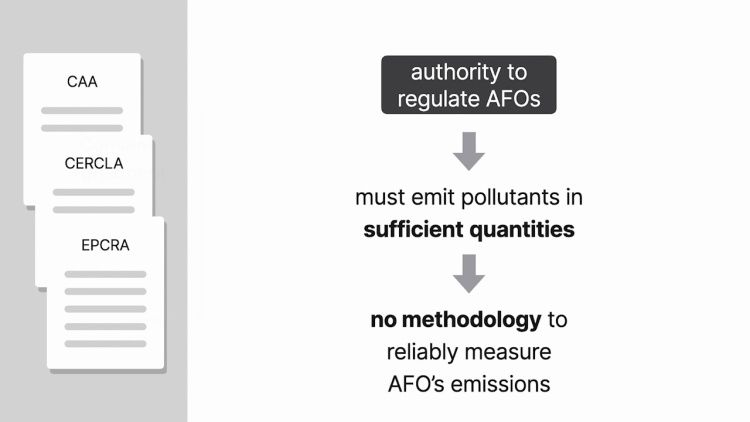Association of Irritated Residents v. EPA
United States Court of Appeals for the District of Columbia Circuit
494 F.3d 1027 (2007)

- Written by Eric Cervone, LLM
Facts
Several community and environmental groups (plaintiffs) maintained that the emissions and odors from animal-feeding operations (AFOs) had negative effects on the plaintiffs’ enjoyment and use of their property and on their health. The facilities of the AFOs, which raised animals for use as food products, produced pollutants that were subject to reporting requirements under the Clean Air Act; the Comprehensive Environmental Response, Compensation, and Liability Act (CERCLA); and the Emergency Planning and Community Right-to-Know Act (EPCRA) (Acts). The Environmental Protection Agency (EPA) (defendant) could only enforce the provisions of the Acts if the EPA measured the levels of an AFO’s emissions and determined whether the emissions exceeded the levels specified in the statutes. However, the parties agreed that there was no methodology available to reliably measure an AFO’s emissions. The EPA determined that the quickest and most efficient solution to this problem was to enter into consent agreements with the AFOs. The agreements provided that the EPA would temporarily refrain from initiating claims against signatory AFOs, which would (1) pay civil penalties that would be used to fund research in the field and (2) allow their facilities to be monitored upon request. The EPA’s Environmental Appeals Board (EAB) approved more than 2,000 consent agreements. The plaintiffs petitioned for review of the agreements, contending that the agreements were rules subject to judicial review under the Administrative Procedure Act (APA), 5 U.S.C. §§ 551-59, that the EPA did not follow the procedures required for rulemaking, and that the EPA did not have the authority to enter into the agreements.
Rule of Law
Issue
Holding and Reasoning (Sentelle, J.)
Dissent (Rogers, J.)
What to do next…
Here's why 899,000 law students have relied on our case briefs:
- Written by law professors and practitioners, not other law students. 47,000 briefs, keyed to 994 casebooks. Top-notch customer support.
- The right amount of information, includes the facts, issues, rule of law, holding and reasoning, and any concurrences and dissents.
- Access in your classes, works on your mobile and tablet. Massive library of related video lessons and high quality multiple-choice questions.
- Easy to use, uniform format for every case brief. Written in plain English, not in legalese. Our briefs summarize and simplify; they don’t just repeat the court’s language.





